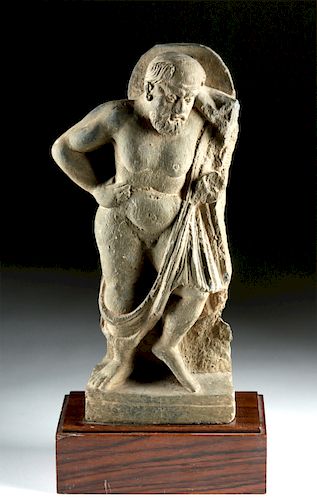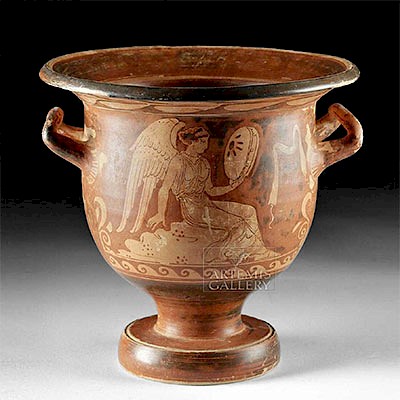Gandharan Schist Carving of Hercules
Lot 134b
About Seller
Artemis Fine Arts
686 S Taylor Ave, Ste 106
Louisville, CO 80027
United States
Selling antiquities, ancient and ethnographic art online since 1993, Artemis Gallery specializes in Classical Antiquities (Egyptian, Greek, Roman, Near Eastern), Asian, Pre-Columbian, African / Tribal / Oceanographic art. Our extensive inventory includes pottery, stone, metal, wood, glass and textil...Read more
Categories
Estimate:
$4,000 - $6,000
Absentee vs Live bid
Two ways to bid:
- Leave a max absentee bid and the platform will bid on your behalf up to your maximum bid during the live auction.
- Bid live during the auction and your bids will be submitted real-time to the auctioneer.
Bid Increments
| Price | Bid Increment |
|---|---|
| $0 | $25 |
| $300 | $50 |
| $1,000 | $100 |
| $2,000 | $250 |
| $5,000 | $500 |
| $10,000 | $1,000 |
| $20,000 | $2,500 |
| $50,000 | $5,000 |
| $100,000 | $10,000 |
| $200,000 | $20,000 |
About Auction
By Artemis Fine Arts
Mar 7, 2019
Set Reminder
2019-03-07 10:00:00
2019-03-07 10:00:00
America/New_York
Bidsquare
Bidsquare : VARIETY SALE | Antiquities & Ethnographic Art
https://www.bidsquare.com/auctions/artemis-gallery/variety-sale-antiquities-ethnographic-art-3928
Around the world & back in time - be amazed at the treasures you will find. Antiquities from Egypt, Greece, Italy and the Near East, Asian, Pre-Columbian, African / Tribal / Oceanic, Native American, Spanish Colonial, Russian Icons, Fine Art, much more! Artemis Fine Arts info@artemisfinearts.com
Around the world & back in time - be amazed at the treasures you will find. Antiquities from Egypt, Greece, Italy and the Near East, Asian, Pre-Columbian, African / Tribal / Oceanic, Native American, Spanish Colonial, Russian Icons, Fine Art, much more! Artemis Fine Arts info@artemisfinearts.com
- Lot Description
Ancient Central Asia, Pakistan, India, and Afghanistan, Gandharan Empire, ca. 3rd to 4th century CE. A gorgeous statue of the mythical Greek hero Hercules carved from grey-brown schist in a classic Greco-Buddhist stylization. Hercules stands nude with an extended left leg, right hand to hip, with a pleated cloak falling from his left shoulder to his right knee. Though missing, his leaning posture would be supported by leaning on his customary wooden club with a lion pelt beneath. The left-turned head boasts a countenance defined by almond-shaped eyes within heavy lids, a slender nose, full lips surrounded by a bushy beard, and a cupped ear, all beneath a bald pate flanked with tufts of hair and framed with a circular nimbus. Custom wooden display stand included. Size: 6.125" W x 12.4" H (15.6 cm x 31.5 cm); 14.8" H (37.6 cm) on included custom stand.
The presentation of this statue is derived from the Roman Farnese Hercules statue (3rd century CE) which was modeled upon an earlier Greek bronze. In terms of iconography, this sculpture references the Greek myth of Hercules' first of twelve labors when King Eurystheus asked Hercules to bring him the skin of a fierce lion that terrorized the hillside around Nemea - a seemingly impossible task. Despite the fact that initially Hercules' arrows were utterly useless against this threatening beast, the hero ultimately succeeded, clutching the lion in his muscular arms all the while strategically avoiding its claws, and finally choking it to death.
Provenance: private Colorado, USA collection; ex-private San Francisco, California, USA collection
All items legal to buy/sell under U.S. Statute covering cultural patrimony Code 2600, CHAPTER 14, and are guaranteed to be as described or your money back.
A Certificate of Authenticity will accompany all winning bids.
We ship worldwide and handle all shipping in-house for your convenience.
#144308Professionally repaired in areas around one leg and peripheries, with small chips and light adhesive residue along break lines. Losses to one arm, nimbus, and areas of peripheries and verso, softening to some finer details, and light encrustations. Light earthen deposits throughout.Condition
- Shipping Info
-
All shipping is handled in-house for your convenience. Your invoice from Artemis Gallery will include shipping calculation instructions. If in doubt, please inquire BEFORE bidding for estimated shipping costs for individual items.
-
- Buyer's Premium



 EUR
EUR CAD
CAD AUD
AUD GBP
GBP MXN
MXN HKD
HKD CNY
CNY MYR
MYR SEK
SEK SGD
SGD CHF
CHF THB
THB














